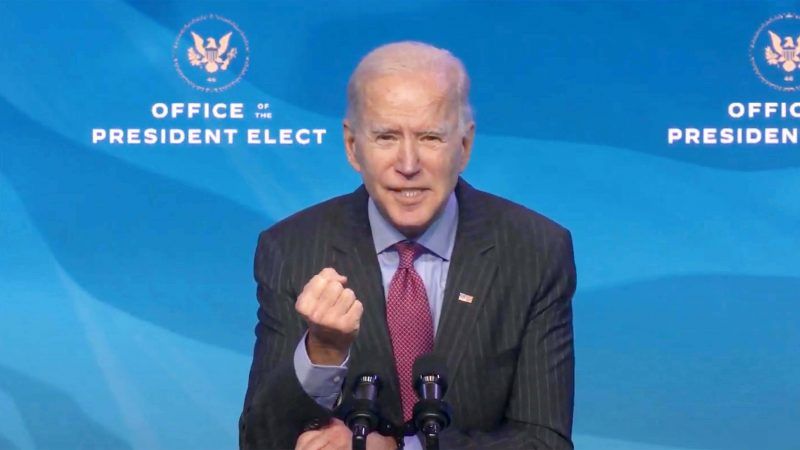Will Joe Biden Destroy Trump's Legacy of Deregulation?
Trump did more than any recent president to pare back regulatory red tape, but the incoming Biden administration is eager to add more.

The most positive aspect of President Donald Trump's legacy is his administration's success at slowing the growth of federal regulations. It's also perhaps his most fragile.
During his first days in office, incoming President Joe Biden is planning to sign "dozens of executive orders, presidential memoranda" which will involve rejoining the Paris Climate Accords, expanding wilderness protections, and moving the country toward a 100 percent "clean energy" economy.
In order to facilitate this flurry of presidential activity, Biden will also need to take aim at Trump's executive orders that attempted to account for the costs of new regulations and limited the number of new rules which could be imposed.
"The priority of the Trump administration has been to reduce regulatory burdens," says James Broughel, a senior research fellow at George Mason University's Mercatus Center. "The Biden administration is going to want to issue lots of new regulations. That's a near certainty. We're going from an era where reducing burdens was the goal to where burdens will be added in the name of achieving certain social goals."
The guiding light of the Trump administration's deregulatory efforts was Executive Order 13771. That 2017 order instituted the famous rule that regulators issue two deregulatory actions for every new regulatory action. It also created a system of accounting for the costs of new regulations and the cost savings of deregulatory actions. This was used to give federal departments regulatory budgets that limited the costs of new regulations they could impose, and often required them to find regulatory savings.
Using this measurement of regulatory savings, the Trump administration has been modestly successful at its goal of deregulating the economy, claiming $198 billion in eliminated regulatory costs. From fiscal years 2017–2019, the administration claims to have eliminated 3.6 rules for every new rule added. That ratio is 3.2 for fiscal year 2020.
Using other measurements, the Trump administration has been less successful. In some areas, they've done more to slow the growth of the administrative state without significantly reducing it. The length of the Code of Federal Regulations stayed essentially flat during Trump's time in office, hovering at around 185,000 pages. The Mercatus Center's tracker of restrictive words in the federal regulatory code comes to a similar result, finding that these words grew from 1.08 million at the beginning of Trump's term to 1.09 million as of January 1, 2021.
Trump "leaves us with fewer regulations than Hillary Clinton would have—though not many fewer regulations than we had before," summarizes Robert Verbruggen in a November National Review article.
One can expect this limited progress to be more than reversed under the new administration. Biden has already announced plans to reinstate Obama-era regulations that were pared back by the Trump administration.
Politico reports that he'll likely try to revive the Obama administration's Clean Power Plan—which regulated carbon dioxide emissions from power plants—that the Trump administration had replaced in 2019. Biden's housing platform calls for a revival of the 2015 Affirmatively Furthering Fair Housing Rule that Trump gutted in July 2020. The Trump administration's replacement of the Obama administration's clean water rules will also likely be ditched.
The incoming administration's attempts to revive big Obama-era rules that Trump eliminated or scaled back will likely spark legal challenges. Biden will still have plenty of room to issue a steady stream of less significant regulations that typically don't attract lawsuits.
In order to facilitate new rules, large and small, Biden will almost certainly rescind Executive Order 13771 and all the limits it imposed on new red tape.
"All the cost caps will probably be eliminated," says Broughel, as will the regulatory budget the Trump administration used to account for the costs of new rules. Doing so would be a "slap in the face at trying to estimate the effects of the regulatory system."
Nevertheless, the fact that the Trump administration was able to adopt a regulatory budget at all proves that it can be done. Other future administrations might be more able and willing to pick it up again.
"I suspect in some form the regulatory budget will come back," says Broughel. "The Trump administration showed that it was workable."
Throughout his presidential campaign, Biden promised Americans a return to normalcy after the unusual, often unsettling administration of Donald Trump. There could be nothing more normal than the federal government issuing a steady stream of red tape without bothering to account for its costs.
Rent Free is a weekly newsletter from Christian Britschgi on urbanism and the fight for less regulation, more housing, more property rights, and more freedom in America's cities.



Show Comments (141)